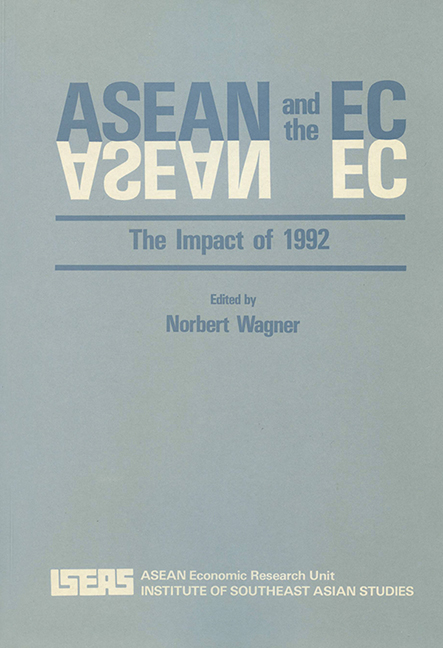Book contents
- Frontmatter
- Contents
- List of Tables
- List of Figures
- Acknowledgements
- PART I INTRODUCTION
- PART II COMPLETING THE EC INTERNAL MARKET
- II Completing the EC Internal Market: An Update and Problems Ahead
- III The EC Internal Market Programme: Implications for External Trade
- IV The EC Internal Market: Implications for Capital Flows
- PART III IMPLICATIONS FOR ASEAN
- Contributors
IV - The EC Internal Market: Implications for Capital Flows
from PART II - COMPLETING THE EC INTERNAL MARKET
Published online by Cambridge University Press: 09 November 2017
- Frontmatter
- Contents
- List of Tables
- List of Figures
- Acknowledgements
- PART I INTRODUCTION
- PART II COMPLETING THE EC INTERNAL MARKET
- II Completing the EC Internal Market: An Update and Problems Ahead
- III The EC Internal Market Programme: Implications for External Trade
- IV The EC Internal Market: Implications for Capital Flows
- PART III IMPLICATIONS FOR ASEAN
- Contributors
Summary
Introduction
The Commission of the European Communities has already set the pace of a complete liberalization of markets for goods and services by 1992. Integration of financial markets has always been seen as a necessary complementary measure to reduce transaction costs and facilitate the creation of an integrated European market for goods.
However, integration of financial markets has shown to be extraordinarily difficult because finance is not only a useful service for trade, but also underlies and influences closely the business cycle, price stability, growth, and income distribution. This chapter attempts to identify the likely effects of financial integration on these major variables, recognizing that the difficulties and final gains of liberalization are likely to be dissimilar for each country, depending on country size, the initial macroeconomic configuration, sophistication of its financial sector, and the degree and extent of regulations to be dismantled.
According to the communication from the Commission to the Council of 23 May 1986, financial integration is expected to proceed in two phases:
The first phase aims at liberalizing those transactions linked to the proper functioning of the common market (free circulation of goods, services, and persons, as well as free establishment) and to the creation of an integrated European Community (EC) capital market (operations in securities).
The second phase aims at creating by 1992 a unified financial system in the Community through the removal of all the remaining restrictions and controls. The intention is to liberalize erga omnes.
Although it is likely that most of the gains from financial market integration will be obtained from unrestricted capital mobility, the Community objective is more ambitious. Instead of aiming at a situation where national financial markets retain their identity, albeit connected through capital flows, the Community aims at a truly integrated market. This requires not only the freedom for consumers/investors to borrow or invest funds outside of national markets but also the right for financial firms to operate and sell throughout the Community.
- Type
- Chapter
- Information
- ASEAN and the ECThe Impact of 1992, pp. 88 - 126Publisher: ISEAS–Yusof Ishak InstitutePrint publication year: 1991

